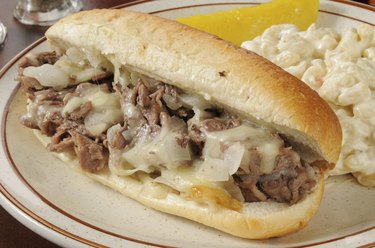
The basic ingredients in a south Philly cheese steak sandwich are bread, thinly sliced beef and cheese with the option of onions, bell peppers or mushrooms. A cheese steak can be high in calories and fat, but it is possible to include it in a healthy diet. The sandwich should be eaten in moderation as part of a diet that is rich in fruits, vegetables, whole grains, low-fat dairy products and lean proteins.
Nutritional Facts
Video of the Day
Penn Medicine analyzed two south Philly cheese steak restaurants and found that the average cheese steak contained 900 calories, 40 g of fat, 50 g of protein and 80 g of carbohydrate. A 7-inch cheese steak at the Cheese Steak Shop in Philadelphia has 476 calories, 26 g of fat, 10 g of saturated fat, 25 g of protein and 35 g of carbohydrate. A 10-inch cheese steak at the Cheese Steak Shop has 789 calories, 49 g of fat, 18 g of saturated fat, 39 g of protein and 57 g of carbohydrate.
Video of the Day
Calories
Federal dietary guidelines recommend about 2,000 calories a day for adults and adolescents. Excess calorie consumption can lead to weight gain, obesity and diseases like diabetes, cancer and stroke. Most of a cheese steak's calories are from the meat and cheese. Classic south Philly cheese steaks use rib eye, which the Mayo Clinic considers a high-calorie cut of beef. The United States Department of Agriculture's (USDA) Nutrient Data Laboratory calculates that 3 oz. of rib eye has 233 calories and 19 g of fat. The most popular cheese on a cheese steak is Cheese Whiz, which has 91 calories and 7 g of fat for 2 tablespoons.
Calories can be decreased by reducing portion size or requesting less meat or cheese. Home cooks should use lean cuts of beef like strip steak or tenderloin and low-fat cheese sauce to make healthier cheese steaks.
Fat
Fat is high in calories. Saturated fat in meat, high-fat dairy products, butter and lard is particularly unhealthy because it contributes to heart disease. The USDA recommends less than 66 g of total fat and 22 g of saturated fat per day on a 2,000-calorie diet. The meat and cheese in a cheese steak are the primary sources of fat; however, the way a cheese steak is cooked also increases the fat content because cheese steaks are often cooked with lots of added oil. Diners can reduce the fat content of a cheese steak by requesting that is be made without added oil.
Sodium
Cheese steaks can be high in sodium (salt). For instance, the 10-inch sandwich at the Cheese Steak Shop has over 1,900 mg of sodium, which is 79 percent of the sodium recommended over an entire day by the USDA. Sodium is an essential nutrient, but too much sodium can cause high blood pressure. High blood pressure is a risk factor for heart attack and stroke. Reducing the portion size of a cheese steak will reduce sodium. Diners should also refrain from adding salt and high-sodium condiments like ketchup, barbecue sauce or steak sauce at the table.
Eating Out
Cheese steaks are often large, which contributes to a high calorie, fat and sodium content. Ordering smaller portions and sharing large portions are better ways to enjoy a cheese steak. For instance, the 6-inch cheese steak at Subway has 530 calories, 18 g of fat, 9 g of saturated fat and 1,570 mg of sodium, while the foot-long version has 1,040 calories, 36 g of fat, 18 g of saturated fat and 3,140 mg of sodium.